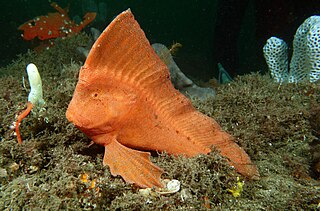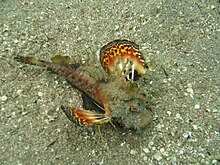
The red velvetfish is a species of marine ray-finned fish, it is the only species in the monotypic genus Gnathanacanthus and monogeneric family Gnathanacanthidae. This species is endemic to the inshore waters of western and southern Australia.

The Australian prowfishes are a small family, the Pataecidae, of ray-finned fishes classified within the order Scorpaeniformes. Australian prowfishes are distinguished by a long dorsal fin that begins far forward on the head, forming a "prow" shape, and extends all the way to the caudal fin. They lack scales and pelvic fins.

Little velvetfishes or simply velvetfishes are a family, the Aploactinidae, of marine ray-finned fishes classified within the order Scorpaeniformes. They are small fish that have skin with a velvet texture. They live on the sea bottom close to the shore, at depths of up to 100 metres (330 ft). They are found in the Indo-Pacific region.

Synanceia nana, the Red Sea stonefish or dwarf scorpionfish, is a species of venomous, marine ray-finned fish, a stonefish belonging to the subfamily Synanceiinae which is classified as being within the family Scorpaenidae, the scorpionfishes and their relatives. It is found in the northwestern Indian Ocean.

Synanceia horrida, the estuarine stonefish, hollow-cheek stonefish, horrid stonefish, rough stonefish or true stonefish, is a species of venomous, marine ray-finned fish, a stonefish belonging to the subfamily Synanceiinae which is classified as being within the family Scorpaenidae, the scorpionfishes and their relatives. It is a benthic fish which is found in the Indo-Pacific region. This species is considered to be one of the most dangerous venomous fish in the world. It is a popular exhibit in public aquaria and is found in the private aquarium trade.

Inimicus didactylus, also known as sea goblin, demon stinger or devil stinger, is a Western Pacific member of the Inimicus genus of venomous fishes, closely related to the true stonefishes. It can reach a body length of 25 cm (10 in) and is irregularly surfaced with spines and a knobby appearance. The fish has venomous spines to ward off enemies. The fish are nocturnal, and often dig themselves partially into the sandy seabed during the day. The body is red or sandy yellow and well camouflaged on sandy and coral seabeds.

Inimicus is a genus of marine ray-finned fishes, it is one of two genera in the tribe Choridactylini, one of the three tribes which are classified within the subfamily Synanceiinae within the family Scorpaenidae, the scorpionfishes and their relatives. These venomous, benthic fishes are found on sandy or silty substrates of lagoon and seaward reefs, in coastal regions of tropical oceans. The ten described species are collectively known by various common names, including ghoul, goblinfish, sea goblin, spiny devilfish, stinger, and stingfish.

Inimicus sinensis, also known as the spotted ghoul, Chinese stinger, spotted stingerfish, or spotted stonefish, is a member of the Inimicus genus of venomous fishes. It is a member of the Synanceiidae family of the Scorpaeniformes order of ray-finned fishes. These benthic fishes are found on sandy or silty substrates of lagoon and seaward reefs, in coastal regions of tropical oceans. Like all the other known species of Inimicus, I. sinensis is a demersal ambush predator. They are nocturnal, and often dig themselves partially into the sandy seabed during the day.

The wasp-spine velvetfish, also known as the dwarf velvetfish, is a species of marine ray-finned fish, a velvetfish belonging to the family Aploactinidae. It is the only member of the monotypic genus Acanthosphex. This species is found in the Indo-Pacific from India to the Gulf of Thailand.

The Southern velvetfish is a species of marine ray-finned fish, a velvetfish belonging to the family Aploactinidae. It is the only member of the monotypic genus Aploactisoma. This species is endemic to the waters around southern and western Australia.
The deceitful velvetfish is a species of marine ray-finned fish, a velvetfish, belonging to the family Aploactinidae. This species is endemic to the oceans around Australia. This species is the only known member of its genus.

The warty prowfish, also known as the smooth prowfish or Tasmanian prowfish, is a species of marine ray-finned fish, an Australian prowfish belonging to the family Pataecidae, It is endemic to the coastal waters of southern Australia where it inhabits mostly rocky reefs. This species is the only member of the monotypic genus Aetapcus.

The whiskered prowfish is a species of marine ray-finned fish, an Australian prowfish belonging to the family Pataecidae. It is endemic to the coastal waters of southern Australia. This species is the only member of the monotypic genus Neopataecus.

The Red Indian fish, also known as the red forehead fish, is a species of marine ray-finned fish, an Australian prowfish belonging to the family Pataecidae. It is endemic to the coastal waters of western and southern Australia where it occurs at depths of from 40 to 80 metres. This species is the only known member of its genus.

The blackfin stonefish is a species of venomous ray-finned fish, a stonefish be longing to the subfamily Synanceiinae of the family Scorpaenidae, the scorpionfishes and their relatives. It is the only species in the monotypic genus. It is native to the western Indian Ocean where it occurs in areas with muddy bottoms. This species grows to a total length of 13 centimetres (5.1 in).

The stargazing stonefish is a species of stonefish native to the Indian Ocean and the western Pacific Ocean where it is found on muddy bottoms in estuaries. This venomous species is also a minor component of local commercial fisheries. This species grows to a length of 8 centimetres (3.1 in) SL. This species is the only known member of the genus Trachicephalus.

Richardsonichthys, is a monotypic genus of marine ray-finned fish belonging to the subfamily Tetraroginae, the waspfishes, which is classified as part of the family Scorpaenidae, the scorpionfishes and their relatives. The only species in the genus is the whiteface waspfish, also known as the whitebelly roguefish, rouge fish, Torres Strait soldier fish or Richardson's waspfish. This species is native to reefs of the Indian Ocean and the western Pacific Ocean.

Scorpaenopsis diabolus, the false stonefish, false scorpionfish or the devil scorpionfish, is a species of venomous marine ray-finned fish belonging to the family Scorpaenidae, the scorpionfishes. It has venomous spines and lives in the tropical Indian and Pacific Oceans as well as in the Red Sea. It is a bottom-dwelling predator that relies on its camouflage to catch passing prey.

Scorpaena plumieri, the spotted scorpionfish, is a species of venomous marine ray-finned fish belonging to the family Scorpaenidae, the scorpionfishes. It is found in the Atlantic Ocean.

Choridactylini, commonly known as stingfishes, stingers or ghouls, is a tribe of venomous ray-finned fishes classified within the subfamily Synanceiinae, the stonefishes, part of the family Scorpaenidae, the scorpionfishes and their relatives. These fishes are found in the Indo-Pacific.





















